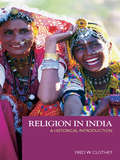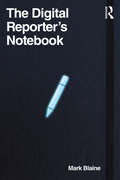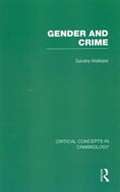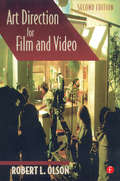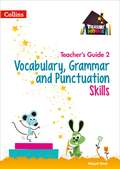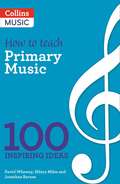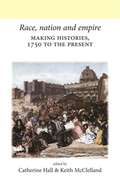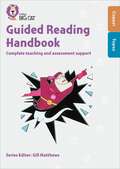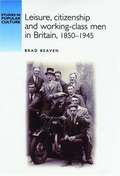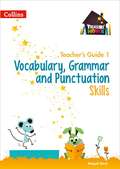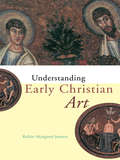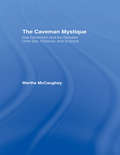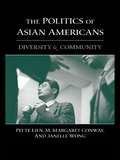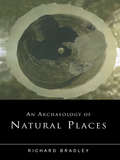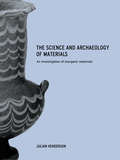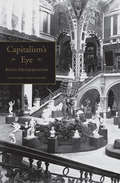- Table View
- List View
Religion in India: A Historical Introduction
by Fred W. ClotheyReligion in India is an ideal first introduction to India's fascinating and varied religious history. Fred Clothey surveys the religions of India from prehistory and Indo-European migration through to the modern period. Exploring the interactions between different religious movements over time, and engaging with some of the liveliest debates in religious studies, he examines the rituals, mythologies, arts, ethics and social and cultural contexts of religion as lived in the past and present on the subcontinent. Key topics discussed include: Hinduism, its origins and development over time minority religions, such as Christianity, Judaism, Islam, Sikhism, Zoroastrianism, Jainism and Buddhism the influences of colonialism on Indian religion the spread of Indian religions in the rest of the world the practice of religion in everyday life, including case studies of pilgrimages, festivals, temples and rituals, and the role of women Written by an experienced teacher, this student-friendly textbook is full of clear, lively discussion and vivid examples. Complete with maps and illustrations, and useful pedagogical features, including timelines, a comprehensive glossary, and recommended further reading specific to each chapter, this is an invaluable resource for students beginning their studies of Indian religions.
The Digital Reporter's Notebook
by Mark BlainePowerful storytelling engages the senses, and today, there are more accessible digital tools available for telling multimedia stories than ever before. The Digital Reporter’s Notebook teaches practical digital storytelling techniques that journalists can put into practice right away, using the technology they already have in their pockets. Mark Blaine demonstrates how to gather information and organize it into a successful multimedia story without losing sight of the essentials of good journalism. These forty brief chapters provide a versatile toolkit for multimedia journalists, including activities and exercises to build a strong foundation in digital storytelling. Readers will also want to try the interactive app, which includes videos and animations that bring the concepts and ideas in the book to life. Topics include: Lighting & Framing Collecting Sound Scene Setting & Relevant Detail Interview Techniques Story Structure File Management The Digital Reporter’s Notebook is ideal for online journalism courses and introductory reporting courses using a convergence approach.
The Digital Reporter's Notebook
by Mark BlainePowerful storytelling engages the senses, and today, there are more accessible digital tools available for telling multimedia stories than ever before. The Digital Reporter’s Notebook teaches practical digital storytelling techniques that journalists can put into practice right away, using the technology they already have in their pockets. Mark Blaine demonstrates how to gather information and organize it into a successful multimedia story without losing sight of the essentials of good journalism. These forty brief chapters provide a versatile toolkit for multimedia journalists, including activities and exercises to build a strong foundation in digital storytelling. Readers will also want to try the interactive app, which includes videos and animations that bring the concepts and ideas in the book to life. Topics include: Lighting & Framing Collecting Sound Scene Setting & Relevant Detail Interview Techniques Story Structure File Management The Digital Reporter’s Notebook is ideal for online journalism courses and introductory reporting courses using a convergence approach.
Gender And Crime: Volume II Gender, Crime, and Criminal Victimisation (PDF)
by Sandra WalklateIn the late 1950s, Barbara Wootton memorably remarked that if men behaved like women the criminal courts would be idle and the prisons empty. Wootton was among the first to ask fundamental and challenging questions of criminology; about its structure as a discipline and its explanatory potential about crime. In the following decades, serious academic work on the relationship between gender, crime, and criminal victimization has continued to flourish. It has been particularly concerned to challenge the sex-based assumptions for female criminality, on the one hand, and the invisibility of women as victims of crime, on the other. If criminology was once a discipline run by the boys, with the boys, about the boys, its domain assumptions are now severely tested in terms of theory, policy, and practice, by a large and growing corpus of scholarship. This new title from Routledge s Critical Concepts in Criminology series meets the need for an authoritative reference work to map and make sense of this body of literature and the continuing explosion in research output. Edited by a leading scholar in the field, Gender and Crime is a four-volume collection which brings together the very best foundational and cutting-edge contributions. The four volumes focus on the nature of the feminist challenge and the criminological response to it. The collection is organized thematically. Volume I ( Sex and Crime or Gender and Crime? ) traces the emergence and development of the gender agenda within criminology, identifying its strengths and weaknesses, while Volume II ( Gender, Crime, and Criminal Victimization ) brings together the best thinking on the various ways in which different crimes and experiences of crime might be informed by a gendered perspective. Volume III ( Gendered Experiences of the Criminal-Justice Process ), meanwhile, focuses on the criminal-justice system and the professionals engaged within it. Does the question of gender help to make better sense of how it does its work? The final volume in the collection ( Gender, Crime, and Punishment ) collects the key literature on the extent to which prisons, community penalties, and restorative justice reflect gendered presumptions. Gender and Crime is fully indexed and has a comprehensive introduction, newly written by the editor, which places the gathered material in its historical and intellectual context. Indeed, it is an essential resource and is destined to be valued by scholars and other users as a vital one-stop research tool. "
Gender And Crime: Volume IV Gender, Crime, and Punishment (PDF)
by Sandra WalklateIn the late 1950s, Barbara Wootton memorably remarked that if men behaved like women the criminal courts would be idle and the prisons empty. Wootton was among the first to ask fundamental and challenging questions of criminology; about its structure as a discipline and its explanatory potential about crime. In the following decades, serious academic work on the relationship between gender, crime, and criminal victimization has continued to flourish. It has been particularly concerned to challenge the sex-based assumptions for female criminality, on the one hand, and the invisibility of women as victims of crime, on the other. If criminology was once a discipline run by the boys, with the boys, about the boys, its domain assumptions are now severely tested in terms of theory, policy, and practice, by a large and growing corpus of scholarship. This new title from Routledge s Critical Concepts in Criminology series meets the need for an authoritative reference work to map and make sense of this body of literature and the continuing explosion in research output. Edited by a leading scholar in the field, Gender and Crime is a four-volume collection which brings together the very best foundational and cutting-edge contributions. The four volumes focus on the nature of the feminist challenge and the criminological response to it. The collection is organized thematically. Volume I ( Sex and Crime or Gender and Crime? ) traces the emergence and development of the gender agenda within criminology, identifying its strengths and weaknesses, while Volume II ( Gender, Crime, and Criminal Victimization ) brings together the best thinking on the various ways in which different crimes and experiences of crime might be informed by a gendered perspective. Volume III ( Gendered Experiences of the Criminal-Justice Process ), meanwhile, focuses on the criminal-justice system and the professionals engaged within it. Does the question of gender help to make better sense of how it does its work? The final volume in the collection ( Gender, Crime, and Punishment ) collects the key literature on the extent to which prisons, community penalties, and restorative justice reflect gendered presumptions. Gender and Crime is fully indexed and has a comprehensive introduction, newly written by the editor, which places the gathered material in its historical and intellectual context. Indeed, it is an essential resource and is destined to be valued by scholars and other users as a vital one-stop research tool. "
Art Direction For Film And Video (PDF)
by Robert OlsonWritten by an author with over 30 years of working experience, this book takes a practical, thorough look at the duties and skills of art directors and production designers. It teaches readers how to analyze a script, develop concepts that meet the needs of a script, develop sketches and construction drawings, work with directors and producers, and operate within budget limitations. The book has been updated and expanded to include interviews with professionals at all levels in the art department. A chapter on digital effects as they relate to the work of the art director has been added to this new edition. Students, novices in the profession, and persons from other art/design fields who are interested in expanding into film and video will find this is a valuable resource. Written by an author with over 30 years of working experience, this book takes a practical, thorough look at the duties and skills of art directors and production designers. It teaches readers how to analyze a script, develop concepts that meet the needs of a script, develop sketches and construction drawings, work with directors and producers, and operate within budget limitations. The book has been updated and expanded to include interviews with professionals at all levels in the art department. A chapter on digital effects as they relate to the work of the art director has been added to this new edition. Students, novices in the profession, and persons from other art/design fields who are interested in expanding into film and video will find this is a valuable resource.
Gender And Crime: Volume I Sex and Crime or Gender and Crime? (PDF)
by Sandra WalklateIn the late 1950s, Barbara Wootton memorably remarked that if men behaved like women the criminal courts would be idle and the prisons empty. Wootton was among the first to ask fundamental and challenging questions of criminology; about its structure as a discipline and its explanatory potential about crime. In the following decades, serious academic work on the relationship between gender, crime, and criminal victimization has continued to flourish. It has been particularly concerned to challenge the sex-based assumptions for female criminality, on the one hand, and the invisibility of women as victims of crime, on the other. If criminology was once a discipline run by the boys, with the boys, about the boys, its domain assumptions are now severely tested in terms of theory, policy, and practice, by a large and growing corpus of scholarship. This new title from Routledge s Critical Concepts in Criminology series meets the need for an authoritative reference work to map and make sense of this body of literature and the continuing explosion in research output. Edited by a leading scholar in the field, Gender and Crime is a four-volume collection which brings together the very best foundational and cutting-edge contributions. The four volumes focus on the nature of the feminist challenge and the criminological response to it. The collection is organized thematically. Volume I ( Sex and Crime or Gender and Crime? ) traces the emergence and development of the gender agenda within criminology, identifying its strengths and weaknesses, while Volume II ( Gender, Crime, and Criminal Victimization ) brings together the best thinking on the various ways in which different crimes and experiences of crime might be informed by a gendered perspective. Volume III ( Gendered Experiences of the Criminal-Justice Process ), meanwhile, focuses on the criminal-justice system and the professionals engaged within it. Does the question of gender help to make better sense of how it does its work? The final volume in the collection ( Gender, Crime, and Punishment ) collects the key literature on the extent to which prisons, community penalties, and restorative justice reflect gendered presumptions. Gender and Crime is fully indexed and has a comprehensive introduction, newly written by the editor, which places the gathered material in its historical and intellectual context. Indeed, it is an essential resource and is destined to be valued by scholars and other users as a vital one-stop research tool. "
Gender And Crime: Volume III Gendered Experiences of the Criminal Justice Process (PDF)
by Sandra WalklateIn the late 1950s, Barbara Wootton memorably remarked that if men behaved like women the criminal courts would be idle and the prisons empty. Wootton was among the first to ask fundamental and challenging questions of criminology; about its structure as a discipline and its explanatory potential about crime. In the following decades, serious academic work on the relationship between gender, crime, and criminal victimization has continued to flourish. It has been particularly concerned to challenge the sex-based assumptions for female criminality, on the one hand, and the invisibility of women as victims of crime, on the other. If criminology was once a discipline run by the boys, with the boys, about the boys, its domain assumptions are now severely tested in terms of theory, policy, and practice, by a large and growing corpus of scholarship. This new title from Routledge s Critical Concepts in Criminology series meets the need for an authoritative reference work to map and make sense of this body of literature and the continuing explosion in research output. Edited by a leading scholar in the field, Gender and Crime is a four-volume collection which brings together the very best foundational and cutting-edge contributions. The four volumes focus on the nature of the feminist challenge and the criminological response to it. The collection is organized thematically. Volume I ( Sex and Crime or Gender and Crime? ) traces the emergence and development of the gender agenda within criminology, identifying its strengths and weaknesses, while Volume II ( Gender, Crime, and Criminal Victimization ) brings together the best thinking on the various ways in which different crimes and experiences of crime might be informed by a gendered perspective. Volume III ( Gendered Experiences of the Criminal-Justice Process ), meanwhile, focuses on the criminal-justice system and the professionals engaged within it. Does the question of gender help to make better sense of how it does its work? The final volume in the collection ( Gender, Crime, and Punishment ) collects the key literature on the extent to which prisons, community penalties, and restorative justice reflect gendered presumptions. Gender and Crime is fully indexed and has a comprehensive introduction, newly written by the editor, which places the gathered material in its historical and intellectual context. Indeed, it is an essential resource and is destined to be valued by scholars and other users as a vital one-stop research tool. "
Vocabulary, Grammar And Punctuation Skills (PDF)
by Abigail SteelTreasure House Vocabulary, Grammar and Punctuation Skills Teacher's Guides provide at-a-glance lesson planning to guide teachers through the activities in Treasure House Vocabulary, Grammar and Punctuation Skills Pupil Books. Treasure House Vocabulary, Grammar and Punctuation Skills Teacher's Guide 2: - provides at-a-glance planning with overviews, step-by-step instructions and answer keys for all Pupil Book units - offers ideas to enable all children to access learning in Support, Embed and Challenge sections - targets individual learning needs with photocopiable resources - maps units to the 2014 National Curriculum for English
100 Ideas For Primary Teachers: Making Musical Schools (PDF)
by David Wheway Hilary Miles Jonathan Barnes100 Ideas provides simple ideas, which are easy to implement, to make primary schools more musical. There are very few resources for primary schools which provide easy dip-in ideas on how to incorporate music within the school day and this book brings together a large number of ideas to inspire and equip teachers, and share good and innovative practice. Music doesn't have to be scary, and there are lots of ways to use music throughout the whole school, in and outside of the curriculum, and at different times of the year. These easy dip-in ideas and activities go across the spectrum, with ideas teachers can take on board easily. * Musical activities * Warm-ups and skill builders * Singing assemblies * Putting on a school musical * Simple concert performances * Inclusion * Liaising with visiting music teachers * Technology * School recordings & CDs * Composers of the week * Visual displays * After-school clubs * Greeting and goodbye songs * Songs to instruct children for activities (make a circle) * Supporting the curriculum music * Liaising with music hubs and external musicians
Race, Nation And Empire: Making Histories, 1750 To The Present (PDF)
by Mcclelland Hall Catherine Hall Keith McClellandThe essays in this collection show how histories written in the past, in different political times, dealt with, considered, or avoided and disavowed Britain's imperial role and issues of difference. Ranging from enlightenment historians to the present, these essays consider both individual historians, including such key figures as E. A. Freeman, G. M. Trevelyan and Keith Hancock, and also broader themes such as the relationship between liberalism, race and historiography and how we mightre-think British history in the light of trans-national, trans-imperial and cross-cultural analysis. "Britishness" and what "British" history is have become major cultural and political issues in our time. But as these essays demonstrate, there is no single national story: race, empire and difference have pulsed through the writing of British history. The contributors include some of the most distinguished historians writing today: C. A. Bayly, Antoinette Burton, Saul Dubow, Geoff Eley, Theodore Koditschek, Marilyn Lake, John M. MacKenzie, Karen O'Brien, Sonya O. Rose, Bill Schwarz, Kathleen Wilson.
Guided Reading Handbook Copper To Topaz (PDF)
by Collins Big Cat Staff Stephanie Austwick Rachel Clarke Kevin Jeffery Gill MatthewsCollins Big Cat Guided Reading Handbooks provide a continuous programme of teaching and assessment that take every reader from phonics to fluency. * Detailed support for both collaborative guided reading sessions and independent sessions for every Big Cat book. * Supports practice of reading comprehension strategies through focused, targeted lesson plans and resource sheets,ensuring every pupil reaches age-related expectations. * Includes advice for demonstration and modelling in every lesson plan, supporting pupils in developing key skills such as inference and deduction from the start. * Vocabulary Boost sessions for every book to extend pupils' expressive and receptive vocabulary. * Formative and summative assessment opportunities to fully assess pupil progress in reading. * Matches to the current programmes of study for English, Science, History and Geography.
Leisure, Citizenship And Working-class Men In Britain, 1850-1945 (PDF)
by Brad BeavenWorking-class culture has often been depicted by historians as an atomised and fragmented entity lacking any significant cultural contestation. Drawing on a wealth of primary and secondary source material, this book powerfully challenges these recent assumptions and places social class centre stage once more. Arguing that there was a remarkable continuity in male working-class culture between 1850 and 1945, Beaven contends that despite changing socio-economic contexts, male working-class culture continued to draw on a tradition of active participation and cultural contestation that was both class- and gender-exclusive, and that the issue of male leisure was intimately linked with contemporary debates on mass society and morality. This lively and readable book uses fascinating accounts from those who participated in and observed contemporary popular leisure making it of interest to students and teachers of social history, popular culture, urban history, historical geography, historical sociology and cultural studies.
Vocabulary, Grammar And Punctuation Skills (PDF)
by Abigail SteelTreasure House Vocabulary, Grammar and Punctuation Skills Teacher's Guides provide at-a-glance lesson planning to guide teachers through the activities in Treasure House Vocabulary, Grammar and Punctuation Skills Pupil Books. Treasure House Vocabulary, Grammar and Punctuation Skills Teacher's Guide 1: - provides at-a-glance planning with overviews, step-by-step instructions and answer keys for all Pupil Book units - offers ideas to enable all children to access learning in Support, Embed and Challenge sections - targets individual learning needs with photocopiable resources - maps units to the 2014 National Curriculum for English
Understanding Early Christian Art
by Robin Margaret JensenUnderstanding Early Christian Art is designed for students of both religion and of art history. It makes the critical tools of art historians accessible to students of religion, to help them understand better the visual representations of Christianity. It will also aid art historians in comprehending the complex theology, history and context of Christian art. This interdisciplinary and boundary-breaking approach will enable students in several fields to further their understanding and knowledge of the art of the early Christian era. Understanding Early Christian Art contains over fifty images with parallel text.
Understanding Early Christian Art
by Robin Margaret JensenUnderstanding Early Christian Art is designed for students of both religion and of art history. It makes the critical tools of art historians accessible to students of religion, to help them understand better the visual representations of Christianity. It will also aid art historians in comprehending the complex theology, history and context of Christian art. This interdisciplinary and boundary-breaking approach will enable students in several fields to further their understanding and knowledge of the art of the early Christian era. Understanding Early Christian Art contains over fifty images with parallel text.
The Caveman Mystique: Pop-Darwinism and the Debates Over Sex, Violence, and Science
by Martha McCaugheyHas evolution made men promiscuous skirt chasers? Pop-Darwinian claims about men's irrepressible heterosexuality have become increasingly common, and increasingly common excuses for men's sexual aggression. The Caveman Mystique traces such claims about the hairier sex through evolutionary science and popular culture. After outlining the social and historical context of the rise of pop-Darwinism's assertions about male sexuality and their appeal to many men, Martha McCaughey shows how evolutionary discourse can get lived out as the biological truth of male sexuality. Although evolutionary scientists want to use their theories to solve social problems, evolutionary narratives get invoked by men looking for a Darwinian defense of bad-boy behaviors. McCaughey argues that evolution has nearly replaced religion as a moral guide for understanding who we are and what we must overcome to be good people. Bringing together insights from the fields of science studies, body studies, feminist theory and queer theory, The Caveman Mystique offers a fresh understanding of science, science popularization, and the impact of science on men's identities making a convincing case for deconstructing, rather than defending, the caveman.
The Caveman Mystique: Pop-Darwinism and the Debates Over Sex, Violence, and Science
by Martha McCaugheyHas evolution made men promiscuous skirt chasers? Pop-Darwinian claims about men's irrepressible heterosexuality have become increasingly common, and increasingly common excuses for men's sexual aggression. The Caveman Mystique traces such claims about the hairier sex through evolutionary science and popular culture. After outlining the social and historical context of the rise of pop-Darwinism's assertions about male sexuality and their appeal to many men, Martha McCaughey shows how evolutionary discourse can get lived out as the biological truth of male sexuality. Although evolutionary scientists want to use their theories to solve social problems, evolutionary narratives get invoked by men looking for a Darwinian defense of bad-boy behaviors. McCaughey argues that evolution has nearly replaced religion as a moral guide for understanding who we are and what we must overcome to be good people. Bringing together insights from the fields of science studies, body studies, feminist theory and queer theory, The Caveman Mystique offers a fresh understanding of science, science popularization, and the impact of science on men's identities making a convincing case for deconstructing, rather than defending, the caveman.
The Politics of Asian Americans: Diversity and Community
by M. Margaret Conway Janelle Wong Pei-Te LienThrough the perspectives of mass politics, this book challenges popular misconceptions about Asian Americans as politically apathetic, disloyal, fragmented, unsophisticated and inscrutable by showcasing results of the 2000-01 Multi City Asian American Political Survey.
An Archaeology of Natural Places
by Richard BradleyThis volume explores why natural places such as caves, mountains, springs and rivers assumed a sacred character in European prehistory, and how the evidence for this can be analysed in the field. It shows how established research on votive deposits, rock art and production sites can contribute to a more imaginative approach to the prehistoric landscape, and can even shed light on the origins of monumental architecture. The discussion is illustrated through a wide range of European examples, and three extended case studies.An Archaeology of Natural Places extends the range of landscape studies and makes the results of modern research accessible to a wider audience, including students and academics, field archaeologists, and those working in heritage management.
An Archaeology of Natural Places
by Richard BradleyThis volume explores why natural places such as caves, mountains, springs and rivers assumed a sacred character in European prehistory, and how the evidence for this can be analysed in the field. It shows how established research on votive deposits, rock art and production sites can contribute to a more imaginative approach to the prehistoric landscape, and can even shed light on the origins of monumental architecture. The discussion is illustrated through a wide range of European examples, and three extended case studies.An Archaeology of Natural Places extends the range of landscape studies and makes the results of modern research accessible to a wider audience, including students and academics, field archaeologists, and those working in heritage management.
The Science and Archaeology of Materials: An Investigation of Inorganic Materials
by Julian HendersonThe Science and Archaeology of Materials is set to become the definitive work in the archaeology of materials. Henderson's highly illustrated work is an accessible and fascinating textbook which will be essential reading for all practical archaeologists. With clear sections on a wide range of materials including ceramics, glass, metals and stone, this work examines the very foundations of archaeological study. Anyone interested in ancient technologies, especially those involving high temperatures, kilns and furnaces will be able to follow in each chapter how raw materials are refined, transformed and shaped into objects. This description is then followed by appropriate case studies which provide a new chronological and geographical example of how scientific and archaeological aspects can and do interact. They include: *Roman pale green and highly decorated glass *17th Century glass in Britain and Europe *the effect of the introduction of the wheel on pottery technology *the technology of Celadon ceramics *early copper metallurgy in the Middle East *chemical analysis and lead isotope analysis of British Bronzes *early copper alloy metallurgy in Thailand *the chemical analysis of obsidian and its distribution *the origins of the Stonehenge bluestones This book shows how archaeology and science intersect and fe ed off each other. Modern scientific techniques have provided data which, when set within a fully integrated archaeological context, have the potential of contributing to mainstream archaeology. This holistic approach generates a range of connections which benefits both areas and will enrich archaeological study in the future.
The Science and Archaeology of Materials: An Investigation of Inorganic Materials
by Julian HendersonThe Science and Archaeology of Materials is set to become the definitive work in the archaeology of materials. Henderson's highly illustrated work is an accessible and fascinating textbook which will be essential reading for all practical archaeologists. With clear sections on a wide range of materials including ceramics, glass, metals and stone, this work examines the very foundations of archaeological study. Anyone interested in ancient technologies, especially those involving high temperatures, kilns and furnaces will be able to follow in each chapter how raw materials are refined, transformed and shaped into objects. This description is then followed by appropriate case studies which provide a new chronological and geographical example of how scientific and archaeological aspects can and do interact. They include: *Roman pale green and highly decorated glass *17th Century glass in Britain and Europe *the effect of the introduction of the wheel on pottery technology *the technology of Celadon ceramics *early copper metallurgy in the Middle East *chemical analysis and lead isotope analysis of British Bronzes *early copper alloy metallurgy in Thailand *the chemical analysis of obsidian and its distribution *the origins of the Stonehenge bluestones This book shows how archaeology and science intersect and fe ed off each other. Modern scientific techniques have provided data which, when set within a fully integrated archaeological context, have the potential of contributing to mainstream archaeology. This holistic approach generates a range of connections which benefits both areas and will enrich archaeological study in the future.
Capitalism's Eye: Cultural Spaces of the Commodity
by Kevin HetheringtonCapitalism's Eye is an extremely ambitious cultural history of how people experienced commodities in the era of industrial expansion. Writing against the dominant argument that the 'society of the spectacle' emerged fully formed in the mid-nineteenth century, Kevin Hetherington explains that the emergence of a culture of mass consumption dominated by visual experience was a much slower process, not truly ascendant until after the First World War. Looking at the department stores, home life, and the great exhibitions around the turn of the last century, Capitalism's Eye promises to transform how we understand both the cultural history of capitalism in America and Europe and the historical roots of the mediated spectacle that dominates our world today.
Capitalism's Eye: Cultural Spaces of the Commodity
by Kevin HetheringtonCapitalism's Eye is an extremely ambitious cultural history of how people experienced commodities in the era of industrial expansion. Writing against the dominant argument that the 'society of the spectacle' emerged fully formed in the mid-nineteenth century, Kevin Hetherington explains that the emergence of a culture of mass consumption dominated by visual experience was a much slower process, not truly ascendant until after the First World War. Looking at the department stores, home life, and the great exhibitions around the turn of the last century, Capitalism's Eye promises to transform how we understand both the cultural history of capitalism in America and Europe and the historical roots of the mediated spectacle that dominates our world today.
